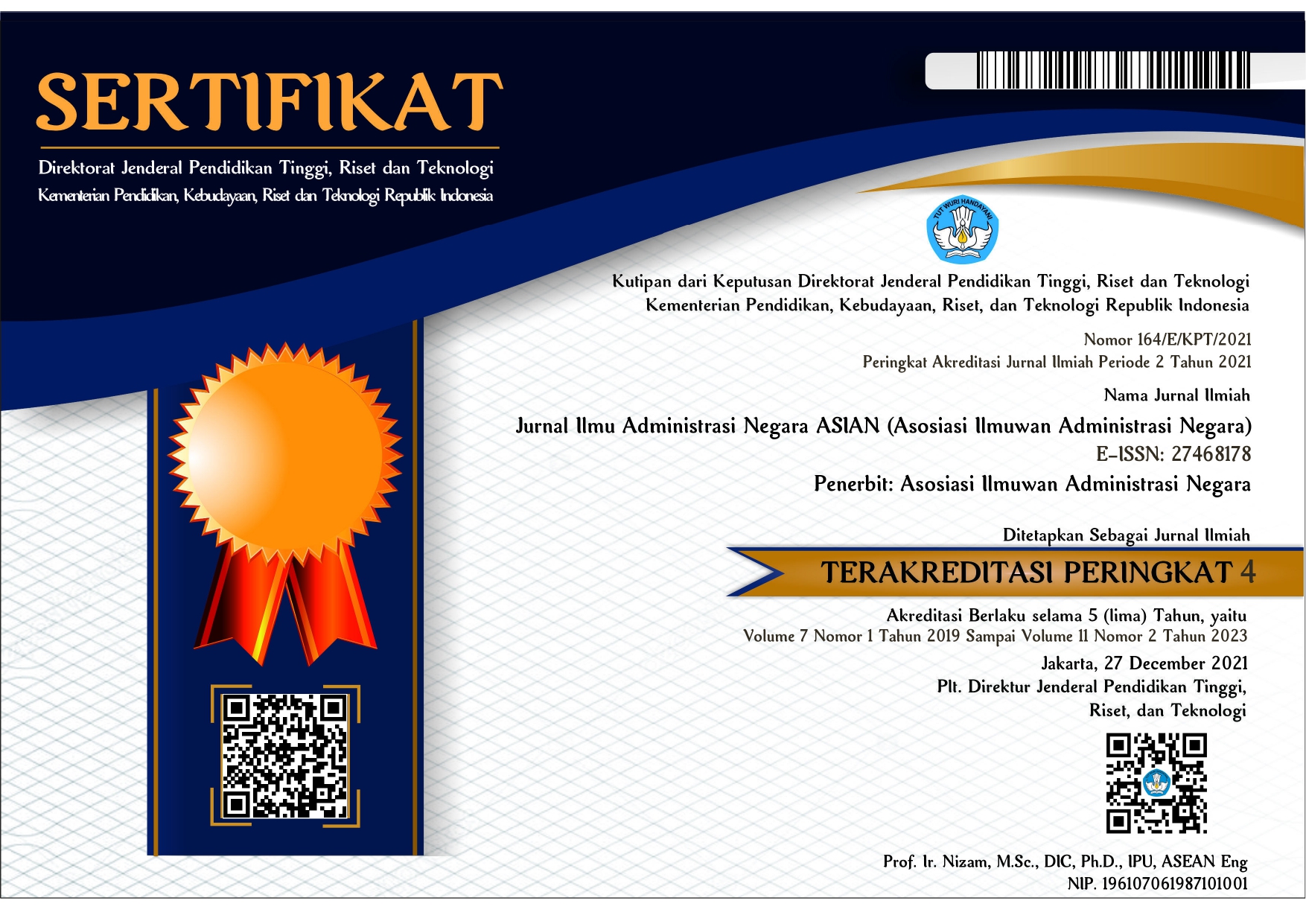Inovasi Pelayanan Publik Program E-Retribusi Di Dinas Perdagangan Kota Surakarta
 Abstract views: 1418
,
Abstract views: 1418
,
 PDF downloads: 3148
PDF downloads: 3148
Abstract
The e-retribution public service innovation by the Surakarta City Trade Office is a new concept regarding the online levy payment system. First launched in mid-2016, E-retribution as part of the implementation of smart government is included in the smart city indicator. This study uses the typology theory of public service innovation Muluk (2008). Research location in the city trade office Surakarta, with a qualitative descriptive method. The data collection technique was obtained by purposive sampling through informant interviews, observations and documents. The results show that the public service innovation with the e-retribution program can simplifying public services and saving more time, costs and human resources, ensuring accountable transactions. In addition, E-retribution has an impact on increasing Solo Local Revenue every year.
Downloads
References
Estermann.,B. Riedl.,R. Neuroni,.A,C. 2009. “Integrated” And “Transcendent” E-government:
Keys For Analyzing Organizational Structure and Governance. A Paper Published in the
Proceedings of the 10th Annual International Conference on Digital Government
Research. Bern University of Applied Sciences. Competence Center Public Management
and E-government. Syamsuadi, Amir. 2017. Pelayanan Publim dan Birokrasi
Pemerintahan. Prodi Ilmu Pemerintahan Universitas Abdurrab.
Ferryanto, Liem. 2009. Inovasi dan Strategi Pencapaiannya. Jurnal Teknik Industri (JTI)
Vol.11.No.2.
Kabir. 2016. Pelayanan Publik Dalam Kerangka Otonomi Daerah. Papers Unisbank Semarang.
Kurniawan Agung;2005; Transformasi Pelayanan Publik, Pembaharuan, Yogyakarta.
Kusumo, A.R. 2006. Analisis Faktor-faktor Yang Mempengaruhi INOVASI Produk Untuk
Meningkatkan Keuanggulan Bersaing dan Kinerja Pemasaran (Studi pada Industri Batik
Skala Besar dan Sedang di Pekalongan). Thesis UNDIP Semarang.
LAN. 2007. Dimensi Pelayanan Publik Dan Tantangannya Dalam Administrasi Negara (Publik)
Di Indonesia. Jakarta: Bagian Humas dan publikasi
Lukas,B. & Ferrel,O. 2000. The Effect of Market Orientation on Product Innovation. Journal of
Academy of Marketing Science.
Muluk, Khairul. (2008). Knowledge Management Kunci Sukses Inovasi Pemerintah Daerah.
Jatim: Bayumedia Publishing
Praswati, A.Nuryulia. 2017. Perkembangan Model Helix Dalam Meningkatkan Inovasi.
Prosiding SEMNAS Riset Manajemen dan Bisnis. FEB Universitas Muhammadiyah
Surakarta.
Rusli Budiman, 2013; Kebijakan Publik Membangun Pelayanan Publik yang Reponsif, Hakim
Publishimg, Bandung.
Sartika, Dewi. 2015. Analisa Inovasi Organisasi Dan Kinerja Organisasi: Studi Kasus Pada Pusat
Kajian Dan Pendidikan Dan Pelatihan Aparatur III Lembaga Administrasi Negara. Jurnal
Borneo Administrator Vol.1.No.2
Wawan Dhewanto dkk. 2014. Managemen Inovasi-Peluang Sukses Menghadapi Perubahan. CV.
Andi Offset:Yogyakarta.
Zulkarnaini; Reinventing Kelembagaan Pemerintah Derah Ynag Ramping Dan Efisiensi. Jurnal
Ekonomi FE UNRIAU. 2013.
Warni, Jurnal Administrasi Bisnis ISSN – 1829 – 5398. Volume 1 Nomor. 2. Juli 2004.
Sedyowidodo Urip dan Susanto Tri, Analisis Pengaruh Pemikiran Kreatif dan Perilaku Inovatif
terhadap Kinerja SDM dengan Metode SEM, Jurnal Manajemen. Vol. XVII, Nomor 03.
Oktober 2013.
Copyright (c) 2020 Jurnal Ilmu Administrasi Negara ASIAN (Asosiasi Ilmuwan Administrasi Negara)

This work is licensed under a Creative Commons Attribution-ShareAlike 4.0 International License.
Authors who publish with this journal agree to the following terms:
1. Copyright on any article is retained by the author(s).
2. The author grants the journal, right of first publication with the work simultaneously licensed under a Creative Commons Attribution License that allows others to share the work with an acknowledgment of the work’s authorship and initial publication in this journal.
3. Authors are able to enter into separate, additional contractual arrangements for the non-exclusive distribution of the journal’s published version of the work (e.g., post it to an institutional repository or publish it in a book), with an acknowledgment of its initial publication in this journal.
4. Authors are permitted and encouraged to post their work online (e.g., in institutional repositories or on their website) prior to and during the submission process, as it can lead to productive exchanges, as well as earlier and greater citation of published work.
5. The article and any associated published material is distributed under the Creative Commons Attribution-ShareAlike 4.0 International License









